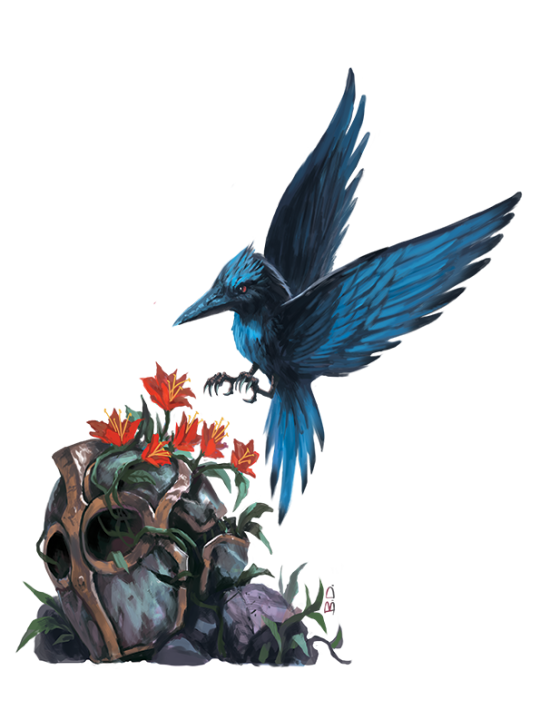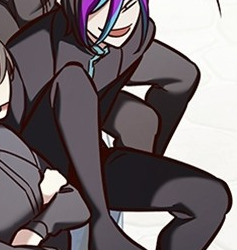Text



yes!!! u r so right for that mr. kayden break!!! i love how ian laughs just like his grandfather but just in Tiny Edition
46 notes
·
View notes
Text
Reasons to read Eleceed - Part 2


29 notes
·
View notes
Text
The Great Game
The galaxy is sick, and has been for so long that even most of the gods have forgotten what it was like when it was healthy. If a cosmology is like an ecosystem, Golarion and its surrounding worlds have too many predators, not enough prey, too much competition, not enough mutualism. The Material Plane is a little too similar to a chaotic, evil world—like the Abyss specifically. On Golarion, it’s kill or be killed.

The reason is Lamashtu. In ages past, the Mother of Monsters ambushed Curchanus, stripping from him the portfolio of Animals and leaving him for dead. He survived long enough to pass his domain of Travel to his protégé, Desna, but Lamashtu was able to use that surge of power to claim divinity for herself and become the Queen of Demons. Since then, Lamashtu has done as she willed, fighting and fucking her way across reality and leaving thousands of new species of horrors in her wake.
But Lamashtu is a neglectful mother. Because of her influence, animals in the Material Plane are overly hostile, too aggressive, liable to pick fights that they can’t win. Animals are liable to view humanoids as prey, which leads to savage reprisals and environmental catastrophe. The species created by Lamashtu and her followers, both demonic and mortal, are born without a niche, and their shoving into the world around them leads to disruption and devastation. It’s not a coincidence that crazed wizards and misguided druids have brought so many new monsters into existence, and that one-off horrors are liable to mutate and become entire species.
But this has not gone unnoticed.

Deep within the First World lives a goddess. A Goddess of Predators, although she is only quasi-divine. For now. Mormo, the First Medusa, Goddess of Predators, has been alive since before the Age of Serpents, since before the birth of mammals. She is a primordial entity, a Great Old One, although more benevolent than most. She and Yig call each other Brother and Sister, although this may or may not represent a genetic linkage. She retreated from the Material Plane as humanity became a growing power, disgusted by the callousness of the Azlanti and the machinations of the aboleths.
But now she has chanced to gaze upon the Material again. And is horrified to see how much things have gotten worse in her absence. Mormo wants to help. And to help the best way she knows how. By killing and eating something. Someone. Lamashtu.
Mormo’s ultimate goal is to do to Lamashtu what Lamashtu did to Curchanus. Weaken her to the point where she can be fought, strip the domain of Animals from her, and ideally kill her for good. Leave the demons without a Queen, so they can go back to clawing at each other’s throats for a while. Restore the ecological balance of Golarion and allow the biological exuberance of the First World back onto the Material Plane.
But she needs help. And Lamashtu may be confident, but she’s not complacent. She knows that Mormo is gunning for her. And is bringing together allies of her own.

This is the Great Game, the cosmological underpinnings of the Age of Monsters. Gods, demigods and other entities are picking sides, or choosing to remain neutral, or remaining neutral on the surface but shoring up their favorites in secret. The teams are not defined by alignment. There are those of all alignments, of all of the planar power groups, who support Team Lamashtu or Team Mormo, in large ways or small. Any conflict where Desna and Pazuzu both have the same enemy is bound to get complicated, after all. Further articles will be posted throughout the year, tagged with The Great Game, discussing who is on who’s side, and why.
Full statistics for Mormo are forthcoming—those are likely going to be the capstone of Monster Girl Summer, posted in August. Mormo is a N great old one, with the portfolio of reptiles, terror and ecology. Her domains are Knowledge, Scalykind, Strength and Trickery, and her subdomains are Competition, Fear (modifying Trickery), Thought and Venom.
178 notes
·
View notes
Text
They look like a group of dark elves.
YALL
MUSE MUSE MUSE MUSE MUSE MUSE MUSE MUSE DKRJENENRJENFJRBTNSNDJSNFKFNHDEHENENFJRNDKNDHERB

ALSO THEM

HOLY FUCK
36 notes
·
View notes
Text
Anaxim

Image © Wizards of the Coast, by Wayne Reynolds
[Commissioned by @justicegundam82. The anaxim was one of the abominations in the D&D 3.0 Epic Level Handbook, and even in its initial appearance seemed like a strange fit. It doesn’t have an epic level CR, at CR 20, and it is the only non-evil abomination. 4e tried to reinvent them by moving them to the Forgotten Realms, and conflating them with a 2e monster family from Dragon Magazine, the sheen. Like most decisions involving the Realms in the 4e era, I hate this and am ignoring it.
My inspiration for the flavor text is as much from conversations with my followers as from any official source. Their first canon backstory is that they are the abandoned creations of a forge god who tried and failed to make an ultimate weapon. The commissioner suggested, in light of this and to give the anaxim something to do other than fight, that they be interested in “fixing” themselves. A conversation with @strawberry-crocodile about one of her upcoming commissions got me thinking about how Pathfinder RPG treats Law vs. Chaos as the big reality-defining conflict as opposed to Good vs. Evil (more traditional fantasy settings) or Evil vs. Evil (the Blood War). And, because of where I am in my life, there’s definitely an element of queer symbolism in this entry as well. Feel free to play that up, or play that down, depending on how you want to use the anaxim in your game.]
Anaxim
CR 17 N Outsider (extraplanar)
This mechanical thing is approximately human shaped, but nearly twice as broad. Its body seems to be made entirely of weapons—it has spinning blades mounted on its back, multiple hooks and cleavers growing along its arms, and a face like a knight’s helmet.
In the war between the inevitables and proteans, there are casualties. Most of these are outright fatalities, but in some cases, an inevitable becomes irreversibly changed by the forces of chaos. When this happens, the inevitable transforms into an anaxim. No two anaxim look identical, but all resemble loosely humanoid metal figures covered in weapons. The primary goal of most anaxim is perfection: making themselves whole and complete in a way that is unique to each individual. Many anaxim would also like to figure out a way to reliably replicate, one that didn’t rely on freak chance and outside intervention. A few anaxim are instead filled with self-loathing and seek to lash out at the forces that made them—these are the most dangerous.
A single anaxim is the equivalent of an entire mortal army, and they are able to go toe-to-toe with all but the most powerful proteans or inevitables alike. As anaxims value their own lives very highly, they usually start a combat cautiously, from a distance or with hit and run attacks. The spinning blades that grow between their shoulders are, when spun fast enough, able to act as a wing, granting the creature remarkable maneuverability for its weight. In addition to their impressive physical weaponry, an anaxim can use a number of spells for defense, and a powerful blast of sonic energy for offense.
Anaxims are insane by the standards of the inevitables, which means that they are capable of respecting and understanding multiple viewpoints. Some maintain a balanced approach to achieving their goals, while others veer wildly between chaotic and lawful behavior. On some occasions anaxim will gather together into groups if their views of perfection overlap. If they do not, such groups rapidly fall apart due to infighting, with anaxim attempting to take control of their peers or simply blast them to pieces with their sonic cones.
Читать дальше
72 notes
·
View notes
Text
Hesperid

Image © Paizo Publishing. Accessed at Archives of Nethys here
[I was not expecting Paizo to make a specific fey based on the Hesperides from Greek mythology instead of just making them nymphs, but I like it.]
Hesperid
CR 9 LN Fey
This humanoid woman has a radiant beauty, her hair and skin colors reminiscent of the light of a sunset. She has long pointed ears and no pupils, marking her fey nature.
The hesperids are fey creatures that guard areas of natural beauty in the mortal realm. They are tied to the setting sun, and their domains always include a good view of the sunset. Hesperids also guard other objects as well—treasures prized by the fey or druidic circles, or historical relics thought lost. These prizes are disguised as golden apples, often mixed with mere trash disguised the same way in order to thwart robbery. More powerful hesperids may guard magical artifacts. In order to defend their landscape and their treasures, hesperids will fight, using conjured sunlight like a druid wields a flame blade.
Because of their ties to the regular cycle of the planet’s orbit, hesperids have lawful minds. Other fey sometimes see them as stodgy, but also respect their reliability and even tempers. Hesperids get along well with most lawful outsiders, as well as bronze and gold dragons, and are stern opponents of forces of undeath. They recognize that darkness has its place in the cosmic order, but are most comfortable in bright lights.
Hesperid Boons and Banes (CL 13th, DC 23)
The most likely boon a hesperid would give to a mortal would be a lesser treasure, typically exchanged for something more relevant to the fey, plus access to the hesperid’s healing magic. Still, some are charmed by mortal artistry, and give their blessings as patrons of the arts. Those who try to steal from a hesperid are sometimes cursed with permanent blindness.
Boon: The glow of the hesperid fills your heart. You gain a +1 sacred bonus to all saving throws, and a +4 competence bonus to all Craft and Perform checks. This bonus lasts for 1 week.
Bane: You are permanently blinded. The blindness can be removed with remove blindness or a similar effect, but returns with the sunrise each day unless it is removed with a break enchantment, limited wish, wish or miracle
Hesperid CR 9
XP 6,400
LN Medium fey
Init +6; Senses low-light vision, Perception +23
Defense
AC 23, touch 23, flat-footed 16(+6 Dex, +1 dodge, +6 deflection)
hp 110 (13d6+65)
Fort +8, Ref +14, Will +12
DR 10/cold iron
Defensive Abilities unearthly grace; Weakness sunset dependent
Offense
Speed 30 ft., fly 60 ft. (good)
Melee sunset ribbon +13/+8 touch (1d10+6 plus 1d6 fire)
Ranged sunset ribbon +13 touch (1d10+6 plus 1d6 fire)
Spell-like Abilities CL 13th, concentration +19 (+23 casting defensively)
At will—daylight, veil (DC 22, self only)
3/day—cure critical wounds (DC 20), quickened glitterdust (DC 18), searing light
Statistics
Str 11, Dex 22, Con 19, Int 18, Wis 19, Cha 22
Base Atk +7; CMB +7; CMD 36
Feats Alertness, Combat Casting,Defensive Combat Training, Dodge, Quicken SLA (glitterdust),Toughness, Weapon Finesse
Skills Acrobatics +21, Bluff +21, Climb +15, Diplomacy +21, Fly +25, Intimidate +18, Knowledge (geography, local, nature) +19, Knowledge (arcana, history) +16, Perception +23, Perform (any one) +21, Sense Motive +23, Stealth + 21
Languages Common, Sylvan, Utopian
SQ golden apple
Ecology
Environment any coastal or hills
Organization solitary or enclave (2-6)
Treasure double standards
Special Abilities
Golden Apple (Su) As a standard action, a hesperid can transform any object of up to 10 cubic feet of material into a golden apple weighing 1 pound. This lasts until the hesperid dismisses the effect as a standard action or if the item has spent 24 hours outside of the hesperid’s bonded location.
Sunset Dependent (Su) A hesperid is mystically bonded to a location that has a good view of the sunset
under ideal conditions—cliffs, islands and valleys are common sites. A hesperid that leaves this area, or who is not outside when the sun sets in that area (even if she can’t see, or if weather hides the sun), takes 1d6 points of Constitution drain per day. A hesperid can bind to a new location with a 24 hour ritual.
Sunset Ribbon (Su) A hesperid can conjure a ribbon of sunlight as a swift action, and dismiss it as a swift action. With this ribbon, she can make melee touch attacks as an attack action, or may snap it like a whip as a standard action to fire a ray up to 180 feet. Regardless of how the hesperid uses it to attack, the sunset ribbon deals 1d10 points of slashing damage modified by the hesperid’s Charisma modifier and 1d6 fire damage. Undead, or other creatures with negative energy affinity, take an additional 1d6 points of damage.
Unearthly Grace (Su) A hesperid gains her Charisma modifier as a deflection bonus to AC and CMD.
123 notes
·
View notes
Text
Sphinx, Astrosphinx

"astrosphinx" © Weasyl user "xdrake", accessed at their gallery here
[Commissioned by @strawberry-crocodile. The astrosphinx is from Spelljammer, but hasn't gotten updated in the 5e Spelljammer box set. Maybe that's because they're super destructive in the original text--it refers to them living on lifeless asteroids because they immediately kill anything that fails to answer their impossible riddles. That makes them seem kind of one-note, and the commissioner asked me to make them more able to interact with other creatures. My idea was to make them malevolent game show hosts. Feel free to draw inspiration from Jigsaw, darker and edgier versions of the Riddler, and Sam Reich on Game Changer.]
Sphinx, Astrosphinx
CR 10 CE Magical Beast
This creature has the body of a lion, and its head is the skull of a ram. A third golden eye is open in its forehead. Its wings, mane and the tuft of its tail are covered in luxurious fur that glimmers with starlight.
An astrosphinx is a mad sphinx capable of flying between worlds. Although they do not talk about their origins, some sages suspect that astrosphinxes arise not through natural birth, but as a metamorphosis when a sphinx delves too deeply into mysteries of a cosmic nature. All astrosphinxes are, by mortal standards, completely insane. Like many other sphinxes, they enjoy riddles, but their riddles are typically nonsense—“what is the speed of blue?” and “how loud is down?” for example. Playing along may mollify an astrosphinx for a while, but it rarely finds the answers of other creatures acceptable in the long term, and responds to spoilsports with physical violence.
Astrosphinxes typically open combat with a breath weapon, a soporific gas. If all of their foes are knocked unconscious, the astrosphinx may take the time to cage their captives, or put them into diabolical traps that torture creatures to death in increments. If their prey remains active, they usually follow up with a blast of chain lightning, followed by melee attacks. Although an astrosphinx’s natural weapons are deadly enough, their dewclaws are flexible enough to act like thumbs, and some carry oversized weapons into combat as well.
An astrosphinx loves to subject other creatures to its riddles, whether they want to play or not. Most astrosphinxes have a dungeon complex rigged with traps and torture implements, sometimes staffed with lesser creatures that have agreed to serve the astrosphinx in exchange for room, board and their lives. Astrosphinxes act as deranged quiz-masters, subjecting their captives to trivia contests, word games and their obtuse riddles, increasing their torment by inches when they fail to answer correctly, and dialing up towards lethality if people refuse to play along. Some of these complexes exist in air pockets on asteroids floating through space, so even surviving an escape becomes part of the challenge (and sometimes a part of the challenge that the astrosphinx encourages).
Astrosphinx CR 10
XP 9,600
CE Large magical beast
Init +5; Senses darkvision 60 ft., Perception +11
Defense
AC 24, touch 10, flat-footed 23 (-1 size, +1 Dex, +14 natural)
hp 133 (14d10+56)
Fort +13, Ref +9, Will +9
Immune confusion and insanity effects
SR 21
Offense
Speed 40 ft., fly 60 ft. (poor)
Melee 2 claws +19 (2d6+6), bite +19 (2d8+6), gore +19 (2d4+6) or masterwork Large greatsword +20/+15/+10 (2d8+9/19-20), bite +17 (2d8+3), gore +17 (2d4+3)
Space 10 ft.; Reach 5 ft.
Special Attacks breath weapon (60 foot cone, sleep 1d6 minutes, Fort DC 21 negates, 1d4 rounds)
Spell-like Abilities CL 10th, concentration +16
Constant—see invisibility
3/day—chain lightning (DC 22)
Statistics
Str 22, Dex 13, Con 18, Int 16, Wis 11, Cha 23
Base Atk +14; CMB +23; CMD 34 (38 vs. trip)
Feats Blind Fight, Hover, Improved Initiative, Iron Will, Martial Weapon Proficiency (greatsword), Multiattack, Power Attack
Skills Bluff +16, Craft (traps) +15, Disable Device +13, Fly +5, Intimidate +16, Knowledge (any one) +13, Perception +11, Sense Motive +8; Racial Modifiers +4 Craft (traps), +4 Disable Device
Languages Aklo, Common, Sphinx
SQ madness, no breath, starflight
Ecology
Environment any land or underground
Organization solitary
Treasure standard (Large masterwork greatsword, other treasure)
Special Abilities
Madness (Ex) An astrosphinx uses their Charisma modifier on Will saves instead of their Wisdom modifier, and are immune to insanity and confusion effects. Only a miracle or wish can remove an astrosphinx’s madness. If this occurs, the astrosphinx gains 6 points of Wisdom and loses 6 points of Charisma.
Starflight (Su) An astrosphinx can survive in the void of outer space. It flies through space at an incredible speed. Although exact travel times vary, a trip within a single solar system should take 3d20 hours, while a trip beyond should take 3d20 days (or more, at the GM's discretion)—provided the astrosphinx knows the way to its destination.
113 notes
·
View notes
Text
Tiddalik

Image © Paizo Publishing, accessed at Archives of Nethys here
[The three themes I'm working with in April are PF2e conversions, wrapping up the World Tour of Oceania, and starting on commissions. This is all three! Commissioned by @vonbaghager. Tiddalik the Greedy Frog is one of the Australian Aboriginal monsters with the highest profile among Westerners, being the subject of children's books, children's plays and an episode of the PBS show Super Why! (sort of a superhero-themed Reading Rainbow analogue). Notably, this behavior is at least thematically consistent with real frogs. The water-storing frog estivates underground during the dry season in a mucus cocoon filled with water, sort of like a lungfish. ]
Tiddalik
CR 7 NE Magical Beast
This creature is a frog the size of a wagon, its body grossly swollen. You can hear the faint sloshing of water inside it as it moves and speaks.
Tiddaliks are monstrous frogs native to desert climes that survive the long period between rains by absorbing water like a living sponge. Unfortunately, they are peevish and cruel, and move from place to place absorbing as much water as they can, even if they don’t need it, simply for the joy of depriving others. In the desert, tiddaliks are seen as physical embodiments of selfishness and greed, and many tales and legends have sprung up around them. Some of them are even true—the idea that a tiddalik can be tricked into expelling its water with a hearty belly laugh is one of them. Unfortunately, tiddaliks are most easily amused by suffering.
A tiddalik rarely starts fights on their own—although they are carnivorous, they prefer to eat things that can’t fight back, sniping small game with blasts of pressurized water. These jets are also used as a defensive weapon until enemies get close enough that the tiddalik can grab them in its jaws and crush them. Few tiddaliks will bother to chase down fleeing enemies, but likewise they are often too stubborn to flee or surrender themselves.
A tiddalik is about ten feet in diameter. They weigh over twenty tons when waterlogged, and about one ton when empty.
Tiddalik CR 7
XP 3,200
NE Huge magical beast (amphibious)
Init +2; Senses low-light vision, Perception +13
Defense
AC 19, touch 10, flat-footed 17 (-2 size, +2 Dex, +9 natural)
hp 92 (8d10+54)
Fort +12, Ref +8, Will +6
Weakness mirthful
Offense
Speed 10 ft., swim 10 ft.
Melee bite +12 (1d10+9 plus grab)
Ranged spit +8 (2d6+6 bludgeoning)
Space 15 ft.; Reach 10 ft.
Special Attacks disgorge, expel wave
Statistics
Str 23, Dex 15, Con 23, Int 6, Wis18, Cha 10
Base Atk +8; CMB +16 (+20 grapple); CMD 28 (32 vs. trip)
Feats Nimble Moves, Power Attack, Skill Focus (Survival), Vital Strike
Skills Acrobatics +7 (-1 when jumping), Climb +10,Perception +13, Survival +9, Swim +18; Racial Modifiers +4 Acrobatics when jumping, +4 Perception
Languages Common
SQ amphibious, drink abundance
Ecology
Environment warm deserts
Organization solitary or pair
Treasure incidental
Special Abilities
Disgorge (Ex) A tiddalik can release the water in its body willingly as a full round action, and the water is released automatically when the creature is slain. When the tiddalik releases water, it bursts in a 10 foot radius, dealing 8d6 points of bludgeoning damage to all creatures in the area (Ref DC 20 half). This water makes that 10 foot radius difficult terrain. The save DC is Constitution based.
Drink Abundance (Ex) By spending 8 hours, a tiddalik can drink 5000 gallons of water. When it does so, it is considered to be waterlogged, which reduces its speed by 20 feet, but it can use its spit attack and disgorge and expel wave abilities. The statistics above assume that the tiddalik is waterlogged.
Expel Wave (Ex) As a standard action, a tiddalik can shoot high pressure water in a 60 foot cone. All creatures in the area take 4d6 points of damage and are pushed back 10 feet. A successful DC 20 Reflex save halves the damage and negates the push effect. The save DC is Constitution based. A tiddalik can use this ability once every 1d4 rounds, but only when it is waterlogged.
Mirthful (Ex) A tiddalik can be forced to use its disgorge ability with a Perform (comedy) check against a DC of 20 + the tiddalik’s Will save modifier.
Spit (Ex) As a standard action, a tiddalik can spit out a jet of water. Treat this as a thrown weapon with a range increment of 30 feet. A creature struck takes 2d6 bludgeoning damage plus the tiddalik’s Strength bonus.
86 notes
·
View notes
Text
Herexen

Image © Paizo Publishing, accessed at Archives of Nethys here
[As part of PF2e's divesting from the OGL, a number of classic monsters inherited from the 3e Monster Manual and the Tome of Horrors have undergone some branding changes. Ankhegs are ankhravs, treants are arboreals, kytons are velstracs. And huecuvas are now herexens. The name "huecuva" was taken from Mapuche mythology, but the actual entity has nothing to do with undead clerics. And the mechanics of the D&D/PF1e huecuva are a remnant of a Gygaxian-era gotcha encounter--what looked like a kindly cleric infected you with disease by touch--and is weirdly low-intelligence. So I welcome this change to both name and mechanics wholeheartedly.]
Herexen
CR 2 NE Undead
This person is clearly dead, with rotting skin and half-missing facial features. It wears a holy symbol around its neck, but its talisman has been clearly defaced.
When a cleric forsakes their god before dying, their body may rise again as an undead heretic known as a herexen. Herexens hate the god they once worshipped, and go out of their way to desecrate holy spaces, interrupt festivals and slay adherents of the faith. They may attract necromancers or death cultists with their activities, and some even continue to advance as clerics, albeit turning to the worship of some demon lord, god of undeath or similar fell power. Herexens may be found as lone predators, or gathered together into parodies of worshipful congregations. In numbers, herexens often engage in cruel parodies of liturgical ceremonies.
A herexen focuses its attacks on divine spellcasters, especially those that worship the god that they once did. A formerly sacred weapon in their hands becomes a tool against all servants of the divine. Herexens are capable of using some clerical magic, thematically similar to that of the god they once followed. They can also inflict negative energy with a touch, which they use to both harm others and to heal themselves or any undead they may have allied with. When slain, a herexen explodes in a burst of negative energy.
Herexen CR 2
XP 600
NE Medium undead
Init +2; Senses darkvision 60 ft., Perception +9
Defense
AC 14, touch 12, flat-footed 12 (+2 Dex, +2 natural)
hp 18 (2d8+9)
Fort +3, Ref +2, Will +7
Immune undead traits
Offense
Speed 30 ft.
Melee slam +3 (1d4+3) or masterwork dagger +4 (1d4+2 plus blasphemous strike)
Special Abilities death throes
Spell-like Abilities CL 2nd, concentration +5
7/day—bleeding touch (1 round)
3/day—inflict light wounds (DC 14)
1/day—cause fear (DC 14)
Statistics
Str 14, Dex 15, Con -, Int 11, Wis18, Cha 17
Base Atk +1; CMB +3; CMD 15
Feats Toughness
Skills Disguise +8, Knowledge (religion) +9, Perception +9, Stealth +7; Racial Modifiers +4 Knowledge (religion)
Languages Common, Necril
SQ blasphemous focus (Death domain, dagger)
Ecology
Environment any
Organization solitary, pair or congregation (3-12)
Treasure standard (defiled holy symbol, masterwork dagger, other treasure)
Special Abilities
Blasphemous Focus (Ex) All herexens are tied to the god that they worshiped and abandoned in life. This grants them access to a single domain or subdomain of their god (aside from the Good or Healing domains), from which they can use the 1st level granted powers as a 2nd level cleric, and can use the 1st level domain spell as a spell-like ability 1/day. A herexen loses these abilities if it is not carrying or wearing a defiled holy symbol of that god. A herexen also gains proficiency with that god’s favored weapon.
Blasphemous Strike (Su) When wielding the favored weapon of its former god, a herexen deals an additional 1d6 points of damage against extraplanar outsiders or creatures capable of casting divine spells. Its blasphemous strike counts as evil for the purposes of overcoming damage reduction.
Death Throes (Su) When a herexen dies, it explodes in a burst of negative energy, dealing 1d6 points of negative energy damage to all creatures in a 30 foot radius (Will DC 14 halves). The save DC is Charisma based.
89 notes
·
View notes
Text
AAAAAAAAAAAAAAAAAAAAAAAAAAAAAAAAAAAAAAA

I'M SUPPOSED TO BE CRYING AND SCREAMING IN AGONY BC OF HIS RIPPED OFF RIGHT ARM BUT ARTHUR BEING FUCKING SHIRTLESS IS MAKING ME DO THE OPPOSITE GODDAMNIT ARTHUR STOP BEING SO DAMN HOT
67 notes
·
View notes
Text
Harmona

Image © Paizo Publishing, accessed at Archives of Nethys here
[I like the harmona. I enjoy it when fey aren't just pretty humanoids with pointy ears or horns, and a hummingbird that deals sonic damage is a cool mechanical niche. I could see these being excellent as allied NPCs as well as being a cool fight, and they would slot very well into the Kingmaker or Ironfang Invasion APs. A harmona with the blighted fey template would probably be terrifying.]
Harmona
CR 11 CN Fey
This creature appears as a glimmering blue hummingbird, moving so quickly that they eye has a hard time following it. A faint, high pitched whine surrounds it as it buzzes by, and its eyes have a canny look about them.
Harmonas are tiny fey creatures easily mistaken for hummingbirds to the untrained eye. They are found primarily in the First World, where they serve fey nobility as entertainers, scouts and spies. A harmona is constantly on the move, flitting from place to place. They fuel this constant rapid activity with sugar. Nectar is their traditional diet, and most harmonas live in places with ample flowering plants. They readily eat candy, pastries and sweet drinks as well.
Harmonas would rather talk or flee than fight, but they are dangerous if provoked. A harmona’s beak strikes with the force of a shortsword, and worse, carries a powerful sonic charge. The fey can beat its wings in patterns that create sonic vibrations, capable of pushing enemies away or knocking them to the ground. Few harmonas are willing to fight to the death, and so they typically make a break for it once foes are suitably battered and disoriented.
A harmona will happily converse with creatures that it comes across, as long as they are treated with respect. Harmonas have genius level intellects, and find being seen as a mere bird to be a grave insult. Attempting to capture or cage a harmona is a sure invitation to a lesson delivered with sonic damage. Mortals seeking to gain a harmona’s favor can often do so by allowing it to taste some exotic dessert or other sweet it has never tried before. Relying on that bribe can be risky, however; the fey creatures have been occasionally known to bankrupt indulgent mortals with demands for ever more elaborate comestibles.
Harmona CR 11
XP 12,800
CN Tiny fey (extraplanar)
Init +10; Senses arcane sight, low-light vision, Perception +27
Defenses
AC 26, touch 26, flat-footed 19 (+2 size, +6 Dex, +1 dodge, +7 insight)
hp 127 (17d6+68)
Fort +10; Ref +16, Will +17
DR 10/cold iron
Defensive Abilities blur, flit back, insightful defense
Offense
Speed 10 ft., fly 60 ft. (good)
Melee gore +15 (1d6 plus 3d6 sonic plus stun)
Space 2 ½ ft.; Reach 0 ft.
Special Attacks subsonic pulse, ultrasonic thrust
Spell-like Abilities CL 11th, concentration +16
Constant—arcane sight, blur
3/day—deafening song bolt
Statistics
Str 10, Dex 23, Con 16, Int 21, Wis 24, Cha 21
Base Atk +8; CMB +6; CMD 32
Feats Combat Expertise, Defensive Combat Training, Dodge, Great Fortitude, Mobility, Spring Attack, Stealthy, Toughness, Weapon Finesse
Skills Acrobatics +26, Diplomacy +25, Fly +34, Escape Artist +30, Knowledge (arcana) +22, Knowledge (nature) +25, Perform (dance) +25, Perception +27, Sense Motive +27, Spellcraft +22, Stealth +38
Languages Aklo, Auran, Common, Gnome, Sylvan
Ecology
Environment warm and temperate land (First World)
Organization solitary
Treasure incidental
Special Abilities
Flit Back (Ex) As an immediate action once per round, a harmona can fly 10 feet without provoking an attack of opportunity. It may use this ability in response to another creature entering its square or entering an adjacent square.
Insightful Defense (Ex) A harmona adds its Wisdom modifier to its Armor Class as an insight bonus. It retains the bonus when flat-footed, but not when it is stunned or unconscious.
Stun (Su) A creature that takes sonic damage from a harmona’s gore attack must succeed a DC 21 Fortitude save or be stunned for 1 round. The save DC is Constitution based.
Subsonic Hum (Su) As a standard action, a harmona can beat its wings to create a 15 ft. radius burst centered on itself. All creatures in the area take 6d6 points of sonic damage and are knocked prone. A DC 23 Fortitude save halves the damage and negates the prone effect. The save DC is Charisma based.
Ultrasonic Thrust (Su) As a standard action, a harmona can create a 30 foot cone of sonic energy. All creatures in the area take 6d6 points of sonic damage and are pushed backwards 15 feet. A successful DC 21 Reflex save halves the damage and negates the push effect. The save DC is Constitution based.
84 notes
·
View notes










